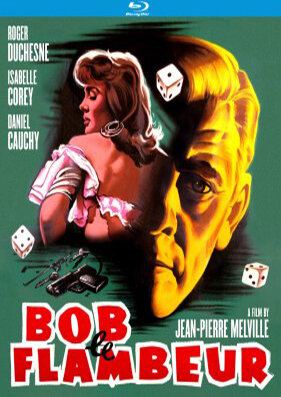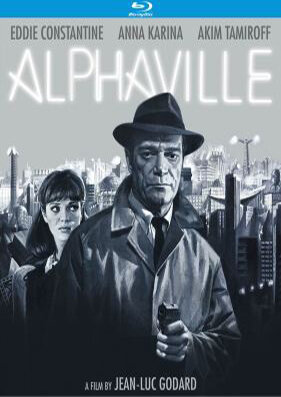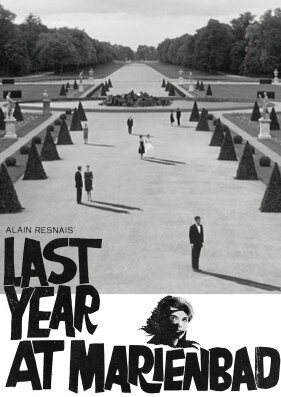GME PRESENTS STREAMLINE: ESSENTIAL FILMS FROM THE FRENCH NEW WAVE ERA NOW AVAILABLE AS DIGITAL SITE LICENSES
/We continue our GME Streamline releases with key films from the Kino Lorber collection, in this instance heralding seminal filmmakers and their movies from the French New Wave era: Jean-Pierre Melville’s BOB LE FLAMBEUR (1956), Jean-Luc Godard’s ALPHAVILLE (1965), and Alain Resnais’s LAST YEAR AT MARIENBAD (1961).
BOB LE FLAMBEUR was Jean-Pierre Melville’s first foray into the stylized underworld which became his signature. Suffused with wry humor, this film melds the toughness of American gangster films with Gallic sophistication to lay the roadmap for the French New Wave. Jean-Luc Godard couldn’t have made BREATHLESS (1959) without BOB LE FLAMBEUR . Melville even appears in BREATHLESS, as a director interviewed by Jean Seberg, proclaiming his desire “to become immortal and then die.” When François Truffaut first saw the film—the first of Melville’s series of film noirs—he exclaimed, “This is the kind of film that we want to make!”
In the opening scene of BOB LE FLAMBEUR, as the neon is extinguished for another dawn, an aging safecracker and compulsive gambler named Bob (Roger Duchesne) navigates the treacherous world of pimps, money men and naïve associates while plotting one last score—the heist of the Deauville casino. Bob lives by night and sleeps by day, and thrives on his nostalgia for the prewar gangster milieu. He cruises Paris streets in a big American car dogged by a daring camera, a swinging jazz track, and a cool obsession. Like Max, the protagonist in Jacques Becker’s heist film TOUCHEZ PAS AU GRISBI (1954), Bob is essentially a loner surrounded with a loyal coterie of men. Whereas Max seems invulnerable, Bob has a fatal flaw. As the title suggests, Bob’s Achilles’ heel is his gambling addiction. From cards and dice to harness racing, if he can bet or play the odds, he does.
Shot on location in crisp, gritty black and white by Henri Decaë (THE 400 BLOWS, 1959, PURPLE NOON, 1960), BOB LE FLAMBEUR’s hand-held shots and natural lighting lend the image a fluidity impossible to achieve in the studio. There are no fancy camera angles, no flashbacks or flash-forwards – just a gritty, rich black and white realism that captures the gaudy glitter and tawdry glamour of Pigalle. Made over a two-year period, Melville pieced together the film when he had enough money to cover the expenses generated by a few days of filmmaking. Beginning shooting on location in 1954 in gambling dens that were soon demolished for housing developments, BOB LE FLAMBEUR is a variation on John Huston’s classic heist film,THE ASPHALT JUNGLE (1950). Melville, an avid admirer and collector of Americana and American crime movies, took much from the gangsters and brooding tough guys in Hollywood pictures of the 1930s and 1940s. Just as depicted in THE ASPHALT JUNGLE, the gang members are all working class men, making the decision that rather than slave in a system in which they could barely survive, a life of crime was viable and logical, and to them, the only alternative. The decision to choose lives of criminality is a major theme in the film. Most of the people in Bob’s circle – while they live and eke out a living from the human vices – now lead more or less straight lives. But their criminal pasts remain. This film is the beginning of what we have now come to think of as Melville’s world – a drily elegant network of interlocking movements and gestures between laconic gangsters, at once powered and haunted by American cinema, but also leading the path toward the French New Wave.
◊
Jean Luc-Godard’s ALPHAVILLE (1965) combines the genres of Film Noir and dystopian science fiction. In his endless journey to mess with cinema’s conventions and tropes, Godard took the well-known cinema hero and transposed him into a sci-fi setting. Secret agent Lemme Caution (played by Eddie Constantine), is sent to the distant space city of Alphaville where he must track down and kill the inventor of the all-controlling computer Alpha 60. As an archetypal American anti-hero private eye in a trenchcoat and with a weathered visage, Lemmy Caution's old-fashioned machismo conflicts with the puritanical computer. This character was a hard-boiled FBI agent from English author Peter Cheyney’s series of novels in the 1930s and 1940s. American expat Eddie Constantine, a craggy-faced tough guy, portrayed Caution in seven pulp detective movies between 1953 and 1963. ALPHAVILLE is replete with hoodlums carrying guns, fisticuffs, and murder, recalling the classic gangster archetypes in American Film Noir (such as THE HITCH-HIKER, 1953, TOO LATE FOR TEARS, 1949, TRAPPED, 1949), and even the French Noir films of Jean Pierre Melville (BOB LE FLAMBEUR, 1956) and Jacques Becker.
Diverging completely from such later science fiction films as 2001: A SPACE ODYSSEY (1968), STAR WARS (1977), BLADE RUNNER (1982), and THE MATRIX (1999), Godard brilliantly eschews futuristic sets and special props for actual Paris locations. Paris of the 1960s was undergoing a dramatic architectural and economic transformation that would see the unprecedented redesign and reconstruction of entire urban districts. The stark tonality of ALPHAVILLE is achieved in great part through the Noir-ish shadows created by accomplished cinematographer Raoul Coutard, whose black-and-white photography turns everyday objects and settings – exteriors of glass buildings, electronic doors, a hotel lobby, spiral staircases, flashing signs, a swimming pool, a room full of mainframe computers, a jukebox, a Kodak Instamatic, the Paris suburbs at night – into the props of a convincingly dystopian world of the future. The neon lights and brutalist architecture lend a futuristic feel to ALPHAVILLE. An otherworldly feel is also created by scenes projected in negative imagery. The lighting and positioning of the camera, by obscuring the envelopes of buildings, serve to disorient a sense of place. For example, as Lemmy Caution drives across a section of an industrial bridge alongside a passing train, the shot obscures the storied history and grandeur of Paris, transforming it instead into an industrialized landscape of a new architectural norm.
◊
LAST YEAR AT MARIENBAD (1961) is a hypnotically beautiful puzzle box of a film, and one of the most influential in the history of cinema. It was created out of a collaboration between its avant-garde nouveau roman writer (and sometime filmmaker) Alain Robbe-Grillet and its director Alain Resnais. In the film’s hypnotic treatment of space, time, and memory, it ushered in a new era of cinematic modernism. In a large international hotel in the European resort town of Marienbad, with a sumptuous but austere décor – a marble universe – a man (Giorgio Albertazzi) is convinced he met an enigmatic woman (Delphine Seyrig) the previous year at the same location, and perhaps had a flirtation. A second man (Sacha Pitoëff), possibly the woman's lover or husband, repeatedly intimidates the first man.Their relationships unfold through shards of flashbacks that never quite fit into place. LAST YEAR AT MARIENBAD is famous for its enigmatic narrative structure, shunning the causal relationship between events. Spatial and temporary continuity is destroyed by the method of filming and editing; the film offers instead a mental continuity, a continuity of thought, as in dreams (indeed, the film was praised by surrealists Jacques Brunius and Ado Kyrou). Time, space and memory are fluid, with no certainty over what is happening to the characters, what they are remembering, and what they are imagining. These ambiguities are further contradicted and amplified by the narrator’s voice-over commentary. The omnipresence of hallway mirrors throughout the film serves to further refract images back upon themselves. The film is cubist in construction, with past, present, and an imagined future folding in on each other.
With Sascha Vierny’s sumptuous black and white widescreen (Dyaliscope) cinematography, the camera glides endlessly throughout the luxuriously baroque hotel. The opening sequence conjures an atmosphere of constriction, with slow tracking shots along ceilings, mirrors, the hotel lobby, and empty corridors. The confining architecture is echoed by the incantatory repetitions of the narrator’s voice, weaving in and out of the soundtrack like a faulty wireless, or a broken record; the desolate organ music and seductive camera movements lull the viewer in to the same trance-like acquiescence as the audience watches what appears to be a tableau vivant, in which the characters move like somnambulists through a hermetically sealed world.
In determining the visual appearance of the film, Resnais said that he wanted to recreate "a certain style of silent cinema", and his direction as well as the actors' make-up sought to produce this atmosphere. The filmmaker showed his costume designer photographs from L'INHUMAINE (1924) and L'ARGENT (1928), for which great fashion designers of the 1920s had created the costumes. He also asked members of his team to look at other silent films including Pabst's PANDORA'S BOX (1929): he wanted Delphine Seyrig's appearance and manner to resemble that of Louise Brooks and Theda Bara. Early in the film, an elaborate full-sized cutout of Alfred Hitchcock makes one of his trademark cameo appearances – easy to miss in the midst of all those mannequin-like patrons. This homage to one of Resnais’ favorite filmmakers illuminates his playful approach to mise-en-scène. It also signals that LAST YEAR AT MARIENBAD can be understood as a mystery, albeit far afield from the narrative style of the Master of Suspense.







